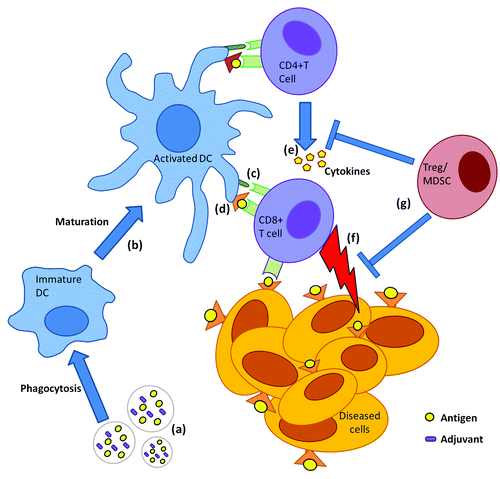Figures & data
Table 1. Summary of murine vaccination experiments comparing immunogenicity of PLGA/PLA particles encapsulating Ag (+/−adjuvant)
Figure 1. OVA-specific CD8+ T-cell frequency in mice vaccinated with polyanhydride microparticles prepared from 50:50 ratio of CPTEG:CPH. Mice were vaccinated twice at 7 d intervals with 100 µg of ovalbumin (OVA) and 50 µg of CpG ODN. Peripheral blood lymphocytes were co-stained using a fluorescently tagged tetramer (binding to OVA/MHC-specific T-cell receptor) and fluorescently labeled anti-CD3 and CD8 antibodies. All groups were statistically compared using ANOVA followed by tukey post-test (*p < 0.05). Adapted from Joshi et al. (2013).Citation58

Figure 2. General mechanism of induction of antigen-specific CD8+ T-cell immunity by biodegradable particles co-encapsulating Ag and adjuvant. Particles co-encapsulating Ag and an adjuvant (A) are phagocytosed by dendritic cells (DCs). DCs undergo maturation (B), upregulating costimulatory molecules (C) and simultaneously cross-presenting Ag in context of MHC class I (i.e., presentation to CD8+ T cells) (D). In the draining lymph node CD8+ T cells become activated (i.e., cytotoxic T cells) and concomitantly activated CD4+ T cells secrete cytokine help (E) to activated CD8+ T cells. Cytotoxic T cells travel via peripheral blood to tumor sites and eradicate Ag expressing cancerous cells or those infected with intracellular pathogens (F). Suppressor cells such as Tregs secrete inhibitory cytokines that prevent T-cell effector activation/function (G) leading to dampening of immune response.
